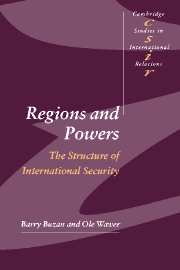Book contents
- Frontmatter
- Contents
- List of illustrations
- Preface
- List of abbreviations
- 1 Patterns of regional security during the Cold War
- 2 Patterns of regional security post-Cold War
- Part I Introduction: developing a regional approach to global security
- Introduction
- 1 Theories and histories about the structure of contemporary international security
- 2 Levels: distinguishing the regional from the global
- 3 Security complexes: a theory of regional security
- Conclusions
- Part II Asia
- Part III The Middle East and Africa
- Part IV The Americas
- Part V The Europes
- Part VI Conclusions
- Glossary
- References
- News media
- Index of names
- General Index
- CAMBRIDGE STUDIES IN INTERNATIONAL RELATIONS
3 - Security complexes: a theory of regional security
Published online by Cambridge University Press: 05 December 2009
- Frontmatter
- Contents
- List of illustrations
- Preface
- List of abbreviations
- 1 Patterns of regional security during the Cold War
- 2 Patterns of regional security post-Cold War
- Part I Introduction: developing a regional approach to global security
- Introduction
- 1 Theories and histories about the structure of contemporary international security
- 2 Levels: distinguishing the regional from the global
- 3 Security complexes: a theory of regional security
- Conclusions
- Part II Asia
- Part III The Middle East and Africa
- Part IV The Americas
- Part V The Europes
- Part VI Conclusions
- Glossary
- References
- News media
- Index of names
- General Index
- CAMBRIDGE STUDIES IN INTERNATIONAL RELATIONS
Summary
This chapter presents an operational version of regional security complex theory (RSCT). RSCT provides a conceptual frame that captures the emergent new structure of international security (1 + 4 + regions): hence our title Regions and Powers. As we have shown, RSCT has a historical dimension that enables current developments to be linked to both Cold War and pre-Cold War patterns in the international system. It contains a model of regional security that enables one to analyse, and up to a point anticipate and explain, developments within any region. RSCT provides a more nuanced view than strongly simplifying ideas such as unipolarity or centre–periphery. But it remains complementary with them, and provides considerable theoretical leverage of its own. In an anarchically structured international system of sufficient size and geographical complexity, RSCs will be an expected substructure, and one that has important mediating effects on how the global dynamics of great power polarity actually operate across the international system. This makes the theory interoperable with most mainstream realist, and much liberal-based, thinking about the international system. In another sense, the theory has constructivist roots, because the formation and operation of RSCs hinge on patterns of amity and enmity among the units in the system, which makes regional systems dependent on the actions and interpretations of actors, not just a mechanical reflection of the distribution of power. Wendt (1999: 257, 301), for example, makes the connection explicit, pointing out that his social theory can be applied to regional security complexes.
- Type
- Chapter
- Information
- Regions and PowersThe Structure of International Security, pp. 40 - 82Publisher: Cambridge University PressPrint publication year: 2003
- 7
- Cited by

